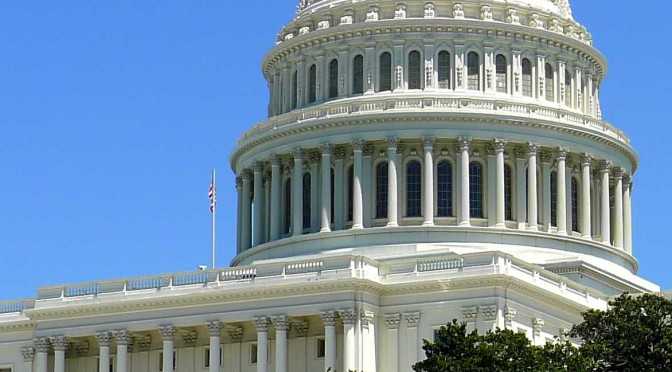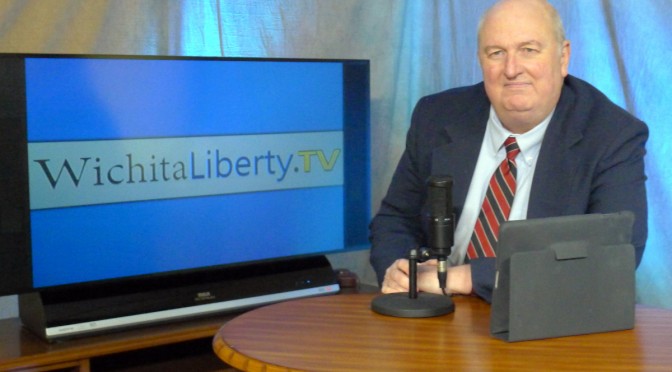As we approach another birthday of Milton Friedman, here’s his article where he clears up the authorship of a famous aphorism, and explains how to really get a free lunch. Based on remarks at the banquet celebrating the opening of the Cato Institute’s new building, Washington, May 1993.
I am delighted to be here on the occasion of the opening of the Cato headquarters. It is a beautiful building and a real tribute to the intellectual influence of Ed Crane and his associates.
I have sometimes been associated with the aphorism “There’s no such thing as a free lunch,” which I did not invent. I wish more attention were paid to one that I did invent, and that I think is particularly appropriate in this city, “Nobody spends somebody else’s money as carefully as he spends his own.” But all aphorisms are half-truths. One of our favorite family pursuits on long drives is to try to find the opposites of aphorisms. For example, “History never repeats itself,” but “There’s nothing new under the sun.” Or “Look before you leap,” but “He who hesitates is lost.” The opposite of “There’s no such thing as a free lunch” is clearly “The best things in life are free.”
And in the real economic world, there is a free lunch, an extraordinary free lunch, and that free lunch is free markets and private property. Why is it that on one side of an arbitrary line there was East Germany and on the other side there was West Germany with such a different level of prosperity? It was because West Germany had a system of largely free, private markets — a free lunch. The same free lunch explains the difference between Hong Kong and mainland China, and the prosperity of the United States and Great Britain. These free lunches have been the product of a set of invisible institutions that, as F. A. Hayek emphasized, are a product of human action but not of human intention.
At the moment, we in the United States have available to us, if we will take it, something that is about as close to a free lunch as you can have. After the fall of communism, everybody in the world agreed that socialism was a failure. Everybody in the world, more or less, agreed that capitalism was a success. The funny thing is that every capitalist country in the world apparently concluded that therefore what the West needed was more socialism. That’s obviously absurd, so let’s look at the opportunity we now have to get a nearly free lunch. President Clinton has said that what we need is widespread sacrifice and concentrated benefits. What we really need is exactly the opposite. What we need and what we can have — what is the nearest thing to a free lunch — is widespread benefits and concentrated sacrifice. It’s not a wholly free lunch, but it’s close.
Let me give a few examples. The Rural Electrification Administration was established to bring electricity to farms in the 1930s, when about 80 percent of the farms did not have electricity. When 100 percent of the farms had electricity, the REA shifted to telephone service. Now 100 percent of the farms have telephone service, but the REA goes merrily along. Suppose we abolish the REA, which is just making low-interest loans to concentrated interests, mostly electric and telephone companies. The people of the United States would be better off; they’d save a lot of money that could be used for tax reductions. Who would be hurt? A handful of people who have been getting government subsidies at the expense of the rest of the population. I call that pretty nearly a free lunch.
Another example illustrates Parkinson’s law in agriculture. In 1945 there were 10 million people, either family or hired workers, employed on farms, and the Department of Agriculture had 80,000 employees. In 1992 there were 3 million people employed on farms, and the Department of Agriculture had 122,000 employees.
Nearly every item in the federal budget offers a similar opportunity. The Clinton people will tell you that all of those things are in the budget because people want the goodies but are just too stingy to pay for them. That’s utter nonsense. The people don’t want those goodies. Suppose you put to the American people a simple proposition about sugar: We can set things up so that the sugar you buy is produced primarily from beets and cane grown on American farms or so the sugar in addition comes without limit from El Salvador or the Philippines or somewhere else. If we restrict you to home-grown sugar, it will be two or three times as expensive as if we include sugar from abroad. Which do you really think voters would choose? The people don’t want to pay higher prices. A small group of special interests, which reaps concentrated benefits, wants them to, and that is why sugar in the United States costs several times the world price. The people were never consulted. We are not governed by the people; that’s a myth carried over from Abraham Lincoln’s day. We don’t have government of the people, by the people, for the people. We have government of the people, by the bureaucrats, for the bureaucrats.
Consider another myth. President Clinton says he’s the agent of change. That is false. He gets away with saying that because of the tendency to refer to the 12 Reagan-Bush years as if they were one period. They weren’t. We had Reaganomics, then Bushonomics, and now we have Clintonomics. Reaganomics had four simple principles: lower marginal tax rates, less regulation, restrained government spending, noninflationary monetary policy. Though Reagan did not achieve all of his goals, he made good progress. Bush’s policy was exactly the reverse of Reaganomics: higher tax rates, more regulation, more government spending. What is Clinton’s policy? Higher tax rates, more regulation, more government spending. Clintonomics is a continuation of Bushonomics, and we know what the results of reversing Reaganomics were.
On a more fundamental level, our present problems, both economic and noneconomic, arise mainly from the drastic change that has occurred during the past six decades in the relative importance of two different markets for determining who gets what, when, where, and how. Those markets are the economic market operating under the incentive of profit and the political market operating under the incentive of power. In my lifetime the relative importance of the economic market has declined in terms of the fraction of the country’s resources that it is able to use. And the importance of the political, or government, market has greatly expanded. We have been starving the market that has been working and feeding the market that has been failing. That’s essentially the story of the past 60 years.
We Americans are far wealthier today than we were 60 years ago. But we are less free. And we are less secure. When I graduated from high school in 1928, total government spending at all levels in the United States was a little over 10 percent of the national income. Two-thirds of that spending was state and local. Federal government spending was about 3 percent of the national income, or roughly what it had been since the Constitution was adopted a century and a half earlier, except for periods of major war. Half of federal spending was for the army and the navy. State and local government spending was something like 7 to 9 percent, and half of that was for schools and roads. Today, total government spending at all levels is 43 percent of the national income, and two-thirds of that is federal, one-third state and local. The federal portion is 30 percent of national income, or about 10 times what it was in 1928.
That figure understates the fraction of resources being absorbed by the political market. In addition to its own spending, the government mandates that all of us make a great many expenditures, something it never used to do. Mandated spending ranges from the requirement that you pay for antipollution devices on your automobiles, to the Clean Air Bill, to the Aid for Disability Act; you can go down the line. Essentially, the private economy has become an agent of the federal government. Everybody in this room was working for the federal government about a month ago filling out income tax returns. Why shouldn’t you have been paid for being tax collectors for the federal government? So I would estimate that at least 50 percent of the total productive resources of our nation are now being organized through the political market. In that very important sense, we are more than half socialist.
So much for input, what about output? Consider the private market first. There has been an absolutely tremendous increase in our living standards, due almost entirely to the private market. In 1928 radio was in its early stages, television was a futuristic dream, airplanes were all propeller driven, a trip to New York from where my family lived 20 miles away in New Jersey was a great event. Truly, a revolution has occurred in our material standard of living. And that revolution has occurred almost entirely through the private economic market. Government’s contribution was essential but not costly. Its contribution, which it’s not making nearly as well as it did at an earlier time, was to protect private property rights and to provide a mechanism for adjudicating disputes. But the overwhelming bulk of the revolution in our standard of living came through the private market.
Whereas the private market has produced a higher standard of living, the expanded government market has produced mainly problems. The contrast is sharp. Both Rose and I came from families with incomes that by today’s standards would be well below the so-called poverty line. We both went to government schools, and we both thought we got a good education. Today the children of families that have incomes corresponding to what we had then have a much harder time getting a decent education. As children, we were able to walk to school; in fact, we could walk in the streets without fear almost everywhere. In the depth of the Depression, when the number of truly disadvantaged people in great trouble was far larger than it is today, there was nothing like the current concern over personal safety, and there were few panhandlers littering the streets. What you had on the street were people trying to sell apples. There was a sense of self-reliance that, if it hasn’t disappeared, is much less prevalent.
In 1938 you could even find an apartment to rent in New York City. After we got married and moved to New York, we looked in the apartments-available column in the newspaper, chose half a dozen we wanted to look at, did so, and rented one. People used to give up their apartments in the spring, go away for the summer, and come back in the autumn to find new apartments. It was called the moving season. In New York today, the best way to find an apartment is probably to keep track of the obituary columns. What’s produced that difference? Why is New York housing a disaster today? Why does the South Bronx look like parts of Bosnia that have been bombed? Not because of the private market, obviously, but because of rent control.
Despite the current rhetoric, our real problems are not economic. I am inclined to say that our real problems are not economic despite the best efforts of government to make them so. I want to cite one figure. In 1946 government assumed responsibility for producing full employment with the Full Employment Act. In the years since then, unemployment has averaged 5.7 percent. In the years from 1900 to 1929 when government made no pretense of being responsible for employment, unemployment averaged 4.6 percent. So, our unemployment problem too is largely government created. Nonetheless, the economic problems are not the real ones.
Our major problems are social — deteriorating education, lawlessness and crime, homelessness, the collapse of family values, the crisis in medical care, teenage pregnancies. Every one of these problems has been either produced or exacerbated by the well-intentioned efforts of government. It’s easy to document two things: that we’ve been transferring resources from the private market to the government market and that the private market works and the government market doesn’t.
It’s far harder to understand why supposedly intelligent, well-intentioned people have produced these results. One reason, as we all know, that is certainly part of the answer is the power of special interests. But I believe that a more fundamental answer has to do with the difference between the self-interest of individuals when they are engaged in the private market and the self-interest of individuals when they are engaged in the political market. If you’re engaged in a venture in the private market and it begins to fail, the only way you can keep it going is to dig into your own pocket. So you have a strong incentive to shut it down. On the other hand, if you start exactly the same enterprise in the government sector, with exactly the same prospects for failure, and it begins to fail, you have a much better alternative. You can say that your project or program should really have been undertaken on a bigger scale; and you don’t have to dig into your own pocket, you have a much deeper pocket into which to dig, that of the taxpayer. In perfectly good conscience you can try to persuade, and typically succeed in persuading, not the taxpayer, but the congressmen, that yours is really a good project and that all it needs is a little more money. And so, to coin another aphorism, if a private venture fails, it’s closed down. If a government venture fails, it’s expanded.
We sometimes think the solution to our problems is to elect the right people to Congress. I believe that’s false, that if a random sample of the people in this room were to replace the 435 people in the House and the 100 people in the Senate, the results would be much the same. With few exceptions, the people in Congress are decent people who want to do good. They’re not deliberately engaging in activities that they know will do harm. They are simply immersed in an environment in which all the pressures are in one direction, to spend more money.
Recent studies demonstrate that most of the pressure for more spending comes from the government itself. It’s a self-generating monstrosity. In my opinion, the only way we can change it is by changing the incentives under which the people in government operate. If you want people to act differently, you have to make it in their own self-interest to do so. As Armen Alchan always says, there’s one thing you can count on everybody in the world to do, and that’s to put his self-interest above yours.
I have no magic formula for changing the self-interest of bureaucrats and members of Congress. Constitutional amendments to limit taxes and spending, to rule out monetary manipulation, and to inhibit market distortions would be fine, but we’re not going to get them. The only viable thing on the national horizon is the term-limits movement. A six-year term limit for representatives would not change their basic nature, but it would change drastically the kinds of people who would seek election to Congress and the incentives under which they would operate. I believe that those of us who are interested in trying to reverse the allocation of our resources, to shift more and more to the private market and less and less to the government market, must disabuse ourselves of the notion that all we need to do is elect the right people. At one point we thought electing the right president would do it. We did and it didn’t. We have to turn our attention to changing the incentives under which people operate. The movement for term limits is one way of doing that; it’s an excellent idea, and it’s making real progress. There have to be other movements as well.
Some changes are being made on the state level. Wherever you have initiative, that is, popular referendum, there is an opportunity to change. I don’t believe in pure democracy; nobody believes in pure democracy. Nobody believes that it’s appropriate to kill 49 percent of the population even if 51 percent of the people vote to do so. But we do believe in giving everybody the opportunity to use his own resources as effectively as he can to promote his own values as long as he doesn’t interfere with anybody else. And on the whole, experience has shown that the public at large, through the initiative process, is much more attuned to that objective than are the people they elect to the legislature. So I believe that the referendum process has to be exploited. In California we have been working very hard on an initiative to allow parental choice of schools. Effective parental choice will be on the ballot this fall. Maybe we won’t win it, but we’ve got to keep trying.
We’ve got to keeping trying to change the way Americans think about the role of government. Cato does that by, among other things, documenting in detail the harmful effects of government policies that I’ve swept over in broad generalities. The American public is being taken to the cleaners. As the people come to understand what is going on, the intellectual climate will change, and we may be able to initiate institutional changes that will establish appropriate incentives for the people who control the government purse strings and so large a part of our lives.








